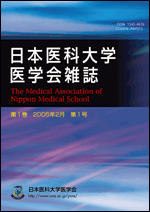Volume 11, Issue 3
Displaying 1-10 of 10 articles from this issue
- |<
- <
- 1
- >
- >|
-
2015Volume 11Issue 3 Pages 133
Published: June 15, 2015
Released on J-STAGE: July 08, 2015
Download PDF (997K)
Photogravure
-
2015Volume 11Issue 3 Pages 134-135
Published: June 15, 2015
Released on J-STAGE: July 08, 2015
Download PDF (278K)
Review
-
2015Volume 11Issue 3 Pages 136-144
Published: June 15, 2015
Released on J-STAGE: July 08, 2015
Download PDF (696K)
-
Recent Reports on Fluid Therapy for Terminally Ill Cancer Patients and Indicators of Quality of Life2015Volume 11Issue 3 Pages 145-150
Published: June 15, 2015
Released on J-STAGE: July 08, 2015
Download PDF (357K) -
2015Volume 11Issue 3 Pages 151-154
Published: June 15, 2015
Released on J-STAGE: July 08, 2015
Download PDF (242K)
Humanities, Natural Sciences, and Medicine
-
2015Volume 11Issue 3 Pages 155-160
Published: June 15, 2015
Released on J-STAGE: July 08, 2015
Download PDF (805K)
Case Reports
-
2015Volume 11Issue 3 Pages 161-166
Published: June 15, 2015
Released on J-STAGE: July 08, 2015
Download PDF (958K)
-
2015Volume 11Issue 3 Pages 167
Published: June 15, 2015
Released on J-STAGE: July 08, 2015
Download PDF (99K)
-
2015Volume 11Issue 3 Pages 168-173
Published: June 15, 2015
Released on J-STAGE: July 08, 2015
Download PDF (724K) -
2015Volume 11Issue 3 Pages 174
Published: June 15, 2015
Released on J-STAGE: July 08, 2015
Download PDF (141K)
- |<
- <
- 1
- >
- >|
